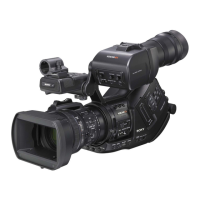Shot Transition
81
Recording
3 When adjustment is finished, press the
Shot A or Shot B button.
The camera settings are registered to the pressed
button.
The registered camera settings are maintained
until you register them next.
Checking the registered settings (Shot)
1 Press the MODE button to display
“Check” in the shot-transition
operation area.
2 Press the A or B button, whichever you
assigned to the shot you wish to check.
The selected shot (camera settings or conditions)
takes effect on the picture on the screen.
With this operation, you cannot check the
conditions of the transition.
When the preparatory settings are completed, you
can start recording.
Operations differ depending the “Rec Link”
setting.
Making a transition from the current
picture to a registered shot
1
Adjust the camera settings to obtain an
image with which you wish to start
recording.
2 Press the MODE button to display
“Execute” in the shot-transition
operation area.
3 Press the REC START/STOP button.
Recording begins.
4 When “Rec Link” is “Off,” press the
button of the target shot (A or B) when
you wish to start the shot transition.
The current camera settings are gradually
shifted to those registered to the specified
shot.
When “Rec Link” is “Shot-A” or “Shot-
B,” the camcorder automatically performs
the shot transition to the camera settings
registered to Shot A or Shot B, respectively.
You need not press the button.
Notes
• You cannot return to the status in step 1 once
after you start the shot transition. If the status
must be resumed, register it as a shot.
• When you perform recording on an external
device connected via the i.LINK(HDV)
connector in synchronization with REC
START/STOP operations on this camcorder,
recording start on the external device and shot-
transition start may not be synchronized even if
“Rec Link” has been set to “Shot-A” or “Shot-
B,” depending on the performance of the
external device.
Making a transition from Shot A to Shot B
When “Rec Link” is set to “Off” or “Shot-B,” a
shot transition from Shot A to Shot B is possible.
1 Press the MODE button to display
“Check” in the shot-transition
operation area.
2 Press the A button.
The picture is adjusted according to the
camera settings registered for Shot A.
3 Press the MODE button to display
“Execute” in the shot-transition
operation area.
4 Press the REC START/STOP button.
Recording begins with the camera settings
registered for Shot A.
5 When “Rec Link” is “Off,” press the B
button when you wish to start the shot
transition.
When “Rec Link” is “Shot-B,” the
camcorder automatically performs the shot
transition to the camera settings registered
for Shot B. It is not necessary to press the B
button.
Recording with a Shot Transition

